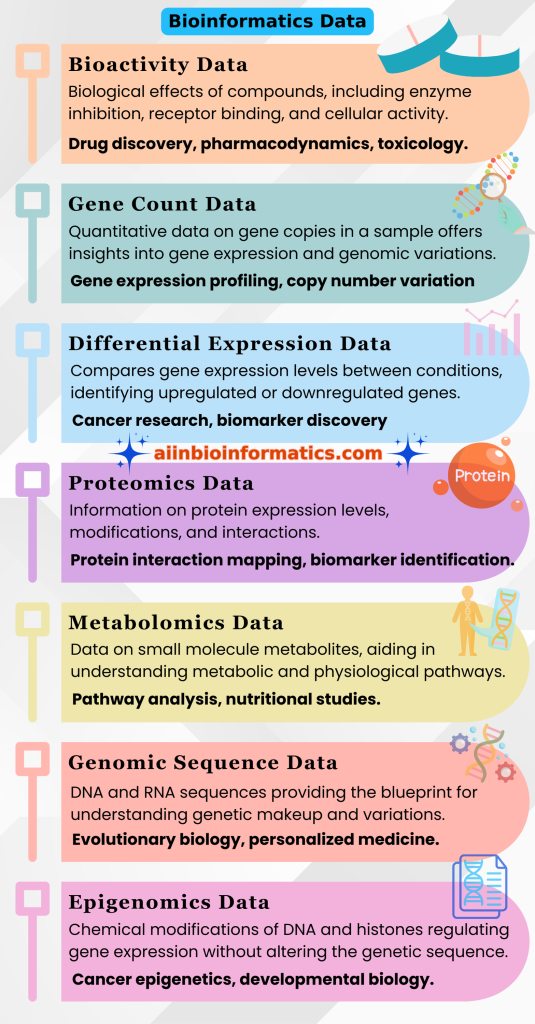Bioinformatics data encompasses various types, each crucial for advancing our understanding of biological systems and enhancing medical research. Bioactivity data reveals how compounds interact with biological systems, essential for drug discovery and safety assessments.
Gene count data provides insights into gene expression and genomic variations, aiding in profiling and predisposition research. Differential expression data compares gene expression across conditions, vital for cancer research and treatment studies.
Proteomics data details protein levels, modifications, and interactions, important for mapping cellular functions and identifying biomarkers. Metabolomics data analyzes small molecule metabolites, crucial for understanding metabolic pathways and disease states.
Genomic sequence data deciphers DNA and RNA sequences, foundational for evolutionary studies and personalized medicine. Lastly, epigenomics data examines chemical modifications that regulate gene expression, pivotal for research in gene regulation and developmental biology.
1. Bioactivity Data
Explanation: Think of bioactivity data as the results of a science experiment where you see how different chemicals or compounds affect biological systems. For example, you might study how a drug interacts with an enzyme in the body, or how it binds to a receptor on a cell surface. This data is essential for understanding the effects and potential therapeutic benefits of new drugs.
Studies: When scientists are in the early stages of drug discovery, they rely heavily on bioactivity data to identify promising compounds. They also use it in pharmacodynamics studies to understand how a drug affects the body over time, and in toxicology assessments to determine the safety of new substances.
2. Gene Count Data
Explanation: Gene count data gives you a snapshot of how many copies of a specific gene are present in a sample. This can tell you a lot about gene expression levels and any variations in the genome. Imagine it like counting the number of copies of a particular book in a library to see how popular or important it is.
Studies: Researchers use gene count data for gene expression profiling, which helps them understand which genes are active and how much they are expressed in different conditions. They also analyze copy number variations to see if certain genes are duplicated or deleted in specific diseases, and study genetic predispositions to see if certain gene patterns are associated with a higher risk of diseases.
3. Differential Expression Data
Explanation: Differential expression data is like a comparison tool that shows how gene expression changes under different conditions. It highlights which genes are turned up (upregulated) or down (downregulated) when comparing, for instance, healthy cells to cancerous cells.
Studies: This data is crucial in cancer research where scientists need to identify which genes are behaving differently in tumors compared to normal tissue. It’s also used in discovering disease biomarkers—molecules that indicate the presence of a disease—and in studying how treatments affect gene expression, helping to tailor therapies more effectively.
4. Proteomics Data
Explanation: Proteomics data deals with the entire set of proteins in a cell, tissue, or organism. It’s like a detailed inventory of all the proteins, including their levels, modifications, and how they interact with each other. Proteins are the workhorses of the cell, so understanding them is crucial for a comprehensive view of biology.
Studies: Scientists map protein-protein interactions to understand cellular functions and pathways. They study post-translational modifications—chemical changes to proteins after they are made—to see how these modifications affect protein function. Identifying protein biomarkers is also a major focus, as these can be used for diagnosing diseases or monitoring treatment responses.
5. Metabolomics Data
Explanation: Metabolomics data provides information about the small molecules, or metabolites, present in a biological sample. These metabolites are the end products of cellular processes and can tell you a lot about the physiological state of an organism. It’s like reading a metabolic “snapshot” that reveals what’s happening inside the cell at a given moment.
Studies: Researchers use metabolomics data to analyze metabolic pathways and understand how different conditions affect metabolism. This is important in studying diseases like diabetes or metabolic disorders. They also use it in nutritional studies to see how diet impacts metabolism and health.
6. Genomic Sequence Data
Explanation: Genomic sequence data consists of the sequences of DNA and RNA, which are essentially the blueprints for all biological functions. This data includes the order of nucleotides in the genome and can reveal genetic variations that might be linked to diseases or traits.
Studies: Genome-wide association studies (GWAS) use this data to identify genetic variants associated with specific diseases. Evolutionary biologists study genomic sequences to understand how species evolve over time. In personalized medicine, doctors use genomic data to tailor treatments based on an individual’s genetic makeup, enhancing the effectiveness and reducing side effects.
7. Epigenomics Data
Explanation: Epigenomics data focuses on the chemical modifications to DNA and histone proteins that regulate gene expression without changing the underlying DNA sequence. It’s like adding notes in the margins of a book to highlight important sections—these modifications tell the cell which genes to read and when.
Studies: Epigenetic regulation research explores how these modifications affect gene activity and how they are involved in development and differentiation. In cancer epigenetics, scientists study how these modifications contribute to cancer progression and look for potential therapeutic targets. Developmental biologists investigate how epigenetic changes guide the development of organisms from embryos to adults.

